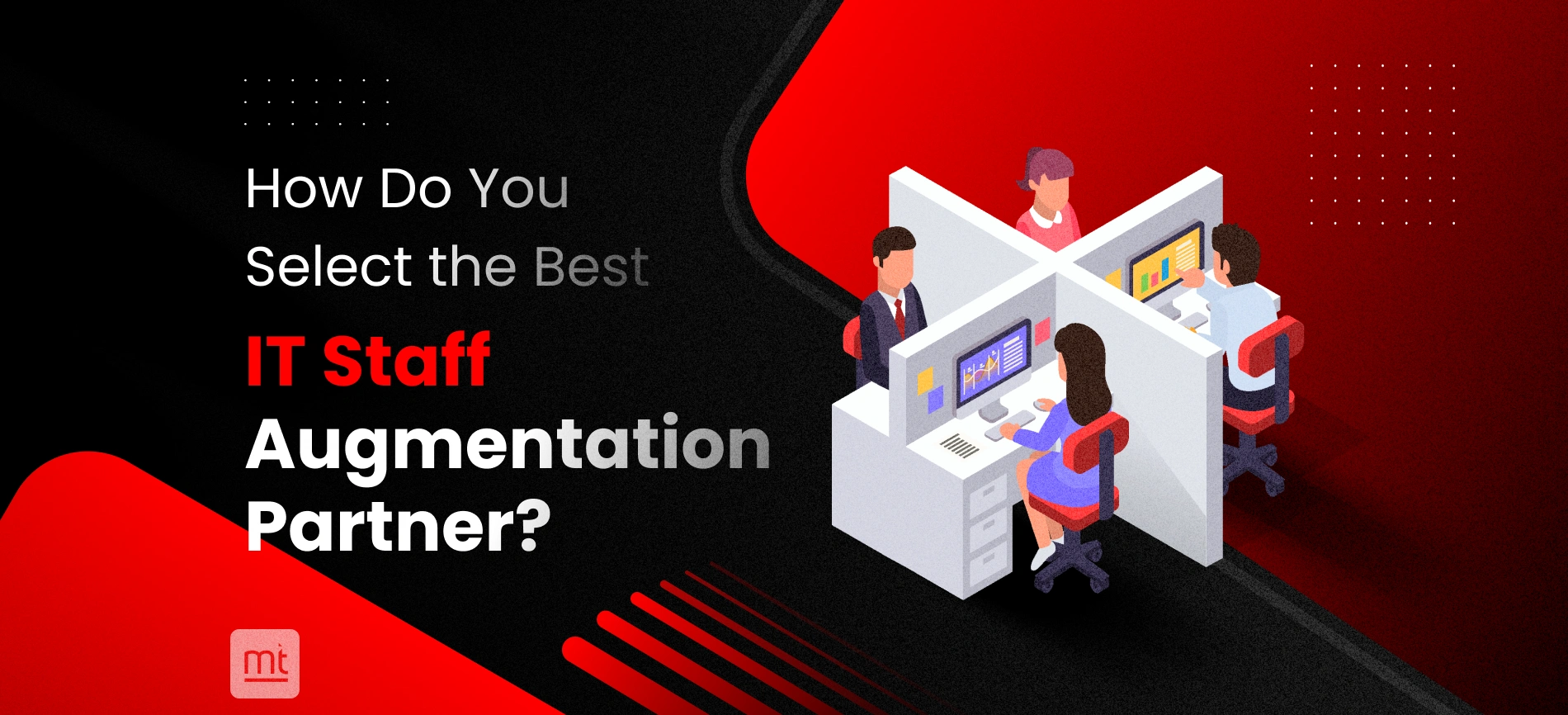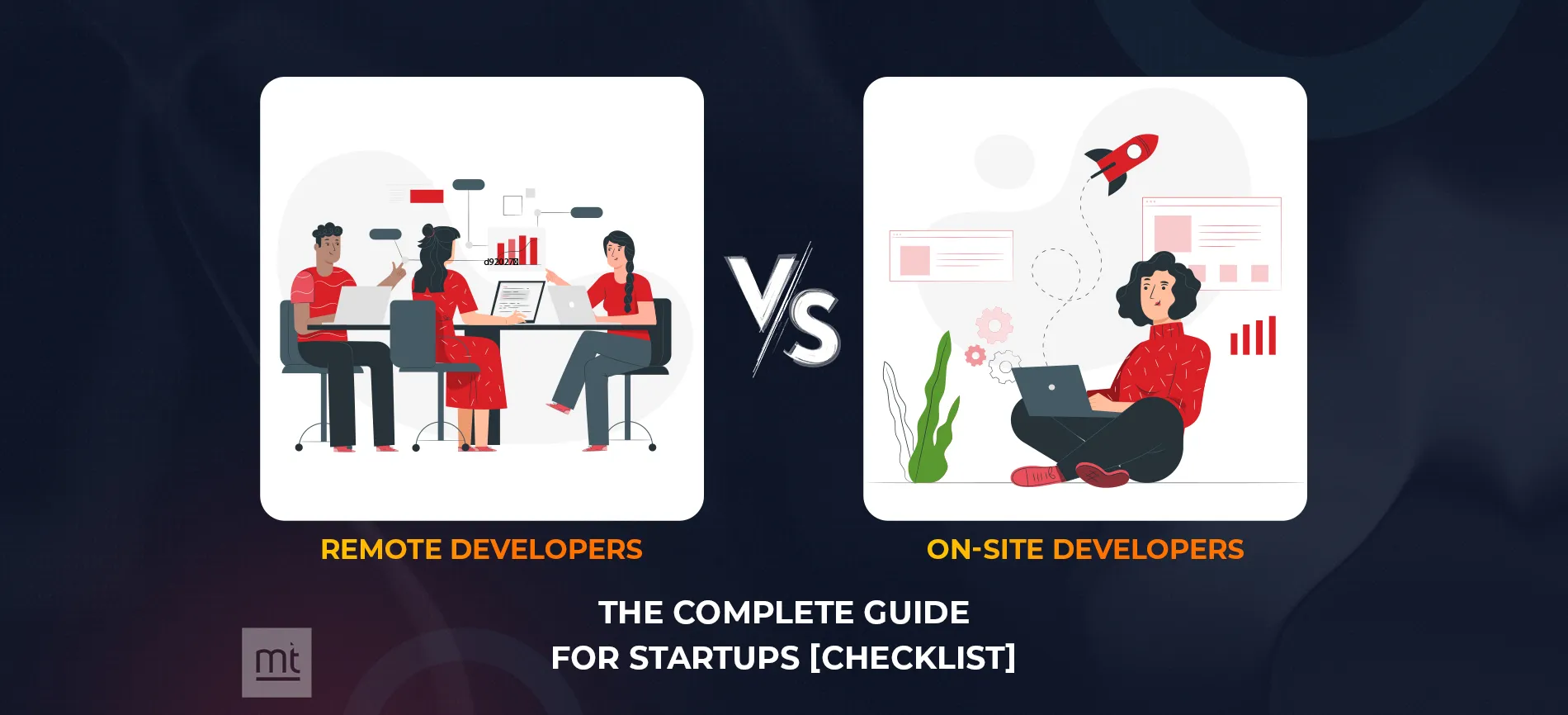Get Free Trial Week Developer Access, Try Before You Hire. Click Here to Claim Now
Key Takeaway:
- What is IT Staff Augmentation?
- Types of IT Staff Augmentation
- Pros and Cons of IT Staff Augmentation
- What are Managed Services?
- Types of Managed Services
- Pros and Cons of Managed Services
- Key Differences Between Staff Augmentation and Managed Services
- How to Choose the Right Model for Your Business?
Introduction:
Previously, recruiting skilled employees was a headache due to lengthy procedures. But things are not the same today. Recruitment has become easier with flexible IT models such as Staff Augmentation and Managed Services. Businesses today are no longer limited by geography or weeks-long hiring rounds. With the growing trend of remote work, skilled employees can be easily found using technology that supports working from a distance and accessing talent on a global scale. Whether you need specialized skills, strategies, or want to fulfill last-minute client needs, these approaches are helping a lot of organizations adapt faster, fill critical skill gaps, and focus on core business growth.
In this article, we will compare Staff Augmentation vs Managed Services in detail to help you understand their pros and cons and decide which one is best according to your business type.
What is IT Staff Augmentation?
Staff augmentation is a flexible business outsourcing model where businesses hire experienced professionals from a third-party vendor to fill their missing skills, resources, and other project gaps.
The IT staff augmentation model is flexible. Means business can hire required experts at any stage of development to overcome specific problems, fill skills/gaps, or meet budget or time constraints.
Types of IT Staff Augmentation
Below is the type of IT staff augmentation model you can hire for:

- Short-Term: Short-term staff augmentation means a business hires experts for a short time or a temporary project to complete urgent project demands, handle seasonal spikes, or meet tight deadlines. It’s best if you need extra employees to complete the work faster without long-term commitments.
- Long-Term: Long-term staff augmentation is the best alternative if you don't want to hire a permanent employee. They can easily manage ongoing projects and are flexible to adjust according to needs.
- Hybrid: A hybrid model is a combination of offshore and onshore teams. It works best if you want to balance cost, project control, and have a good collaboration.
- Skill-Based: This model focuses on hiring professionals with specific technical or domain skills needed for a particular task or phase of a project, ensuring expertise-driven execution.
- Highly Skilled: Highly skilled augmentation brings in top-tier experts with niche or advanced skills. It’s ideal when projects demand deep specialization that’s hard to find in-house or locally.
Pros and Cons of IT Staff Augmentation
Every business model has its own pros and cons, and so do staff augmentation and managed services also have. Let's know the pros and cons of both before we decide which one is better.
Pros of Staff Augmentation:
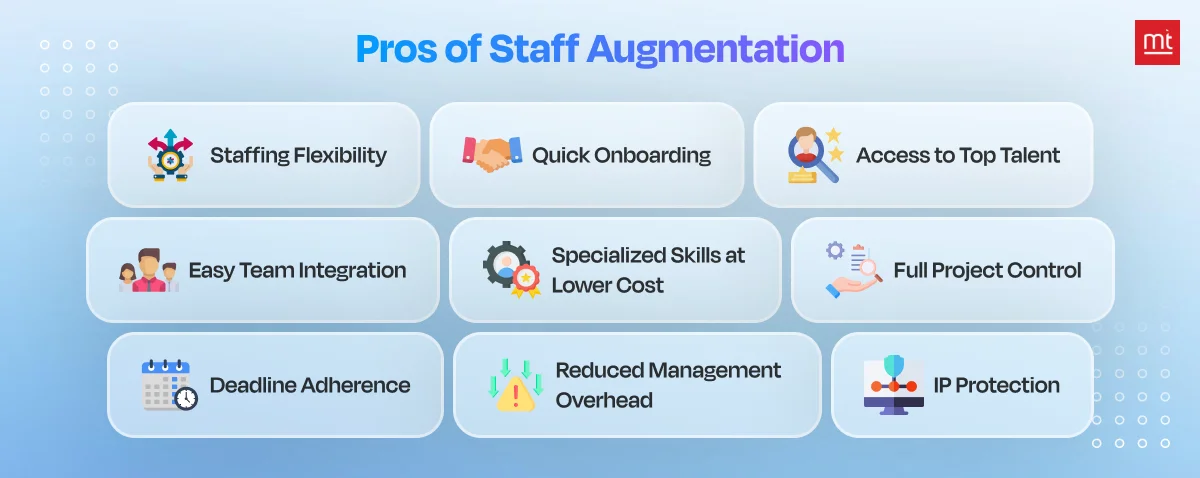
- Staffing Flexibility: You can reduce and add experts to the team according to the project's needs. Plus, you can also add a team of experts to your in-house projects to meet deadlines and ensure faster execution.
- Quick Onboarding: As experts are already experienced and pre-vetted, you can quickly onboard the required experts and launch the product or services faster to the market.
- Access to Top Talent: You can choose from a wide pool of experts according to skills, designation, experience, budget, and filter it according to your needs.
- Easy Team Integration: Augmented teams easily integrate with your existing team without affecting the workflow and other stuff.
- Specialized Skills at Lower Cost: Augmented teams are already trained, hence they are best in their work. Plus, you don't need to pay them full salary.
- Full Project Control: You can control and manage the augmented team according to the project timeline and workflows to align with the project goals.
- Reduced Management Overhead: Vendors handle recruitment and payroll, so your team can focus more on project delivery than administration.
- IP Protection: Since work happens under your processes and systems, you have better oversight and protection of intellectual property.
Cons of Staff Augmentation:

- Suitable for short projects: Staff augmentation is typically best for small, specific, or limited-term projects. Over the longer term, if you use it as an alternative to hiring full-time staff, or to outsourcing in its entirety.
- Requires internal management: Even a staff augmentation model requires guidance, oversight, and a bit of management to fit into an organization’s processes. This means more oversight for your current managers who now have to juggle work, keep eyes on the prize, and the freelancers/tasks, and productivity.
- Hidden cost: Yes, staff augmentation is affordable than hiring full-time, but onboarding time, training, communication overhead, and potential delays can add some expense indirectly.
- Lack of commitment: Temporary professionals may not share the same level of loyalty or long-term interest as full-time employees. Their focus is often limited to the task at hand, which can affect motivation, collaboration, and knowledge retention.
- Security risks: You might need to share the project credentials and access to the external teams for smooth coordination. This is a bit risky as the company details get exposed to other people working remotely.
- Team dynamics challenges: There can be differences in work styles, time zones, or cultural norms that may lead to misunderstandings or friction.
What are Managed Services?
While managed services is a business model where business outsource their IT functions or suitable organizational tasks to third-party vendors. It can be either outsourcing the network department, a suitable project task, security, or more.
In a managed services setup, the provider functions independently of an in-house team within a company. Once the project scope, timeline, and budget have been decided upon, they operate independently on the tasks assigned to them while having frequent check-ins with clients. It’s also a low-cost one because there is no HR overhead, no oversight, or day-to-day management.
Types of Managed Services
There are managed services available for different organizational operations, such as network, security, DevOps, and more. Here are some of the important types listed below.
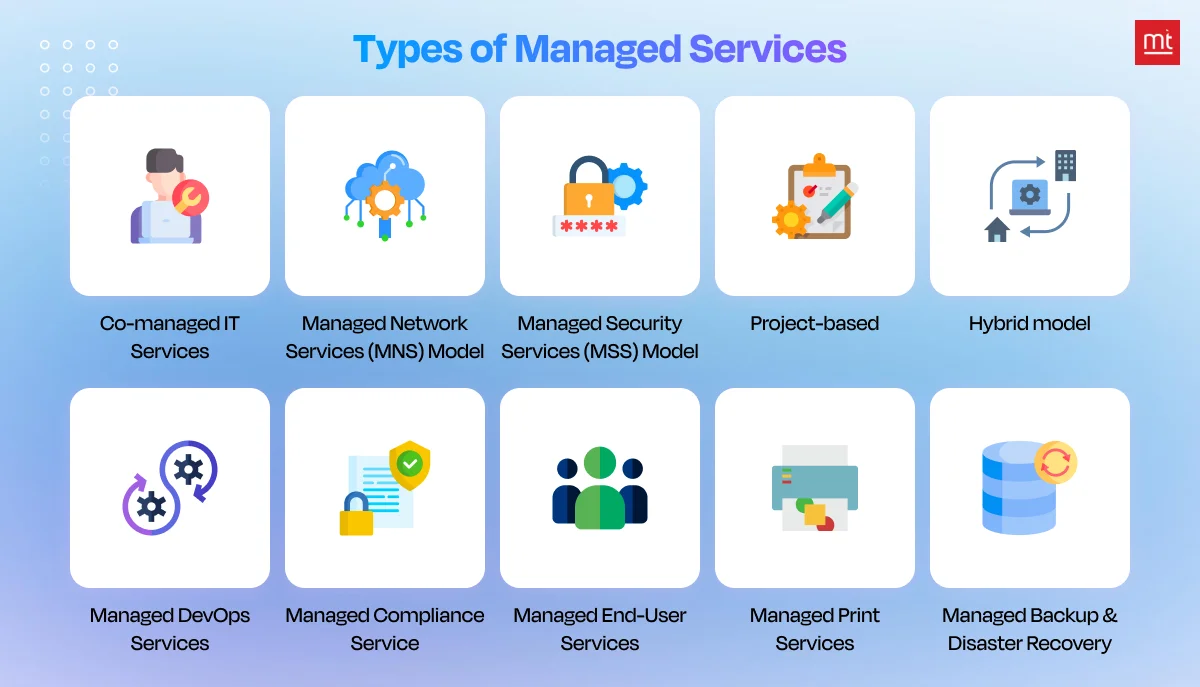
- Co-managed IT Services: In this model, the company’s in-house team and external service providers work together and share IT responsibility.
- Managed Network Services (MNS) Model: MNS is about network services. Businesses hire network services from a provider to improve their network operations, including network infrastructure, monitoring, maintenance, upgrades, and troubleshooting.
- Managed Security Services (MSS) Model: MSS providers handle cybersecurity tasks like threat detection, firewall management and incident response. It’s ideal for businesses who want strong security without investing in an internal security team.
- Project-based: In this model, providers are brought in to manage specific, time-bound IT projects. It’s perfect for implementing new systems or upgrades without straining internal resources.
- Hybrid Model: If any company wants to combine multiple service providers, they can combine and customize multiple services to keep control over certain functions while outsourcing others for cost savings, efficiency or specialized skills.
- Managed DevOps Services: Companies that want to automate deployments, monitor environments and maintain continuous integration and delivery (CI/CD) practices hire managed DevOps services for fast project delivery.
- Managed Compliance Services: These services help businesses meet regulatory and industry compliance standards. Provider monitors and updates policy and monitors your data handling, reporting, and policy updates to reduce risk and ensure legal readiness.
- Managed End-User Services: This model focuses on user support and includes tasks like help desk services, software updates, and device management. It ensures employees have smooth and uninterrupted access to the tools they need.
- Managed Print Services: Providers handle print infrastructure, including device maintenance, supply management, and usage monitoring. It reduces printing costs, streamlines operations, and improves document security.
- Managed Backup & Disaster Recovery: This service ensures your data is backed up regularly and can be restored quickly in case of loss or disruption. It minimizes downtime and protects critical business information.
Pros and Cons of Managed Services
Pros of Managed Services:
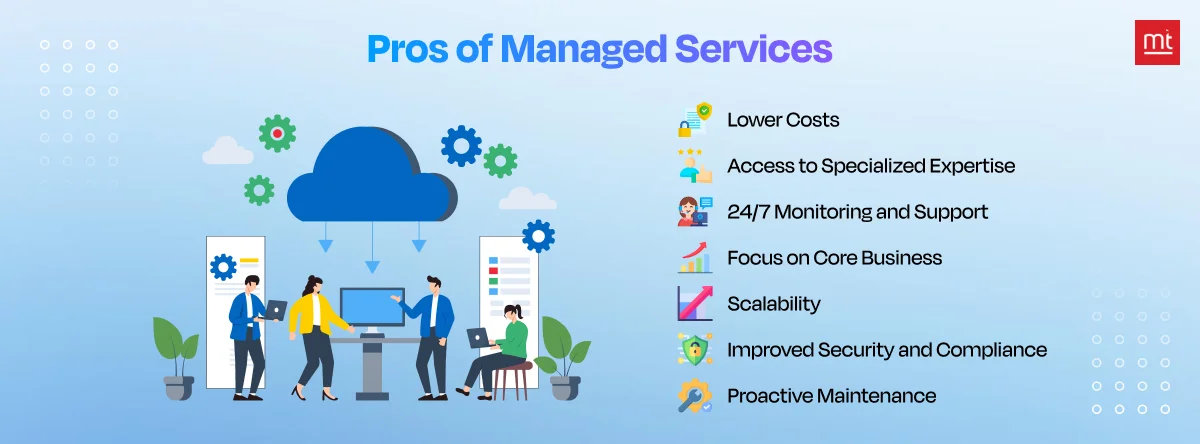
- Lower Costs: You pay a fixed fee, and the service provider will handle everything. This reduces overall expense and headache in the long term because you don't need to deal with system failures and other errors.
- Access to Specialized Expertise: You can get complex organizational operations done without hiring a full-time, expensive expert.
- 24/7 Monitoring and Support: Managed services monitor 24/7, hence there are fewer chances of errors, and even if it's discovered, it will get solved immediately.
- Focus on Core Business: You can easily focus on business, as an IT service provider will handle the IT task on your behalf.
- Scalability: It allows to scale the services by adding and removing according to project demand and company growth.
- Improved Security and Compliance: Providers implement up-to-date security tools and help you meet industry compliance standards.
- Proactive Maintenance: Problems are fixed before they cause downtime, hence it improves overall system health and performance.
Cons of Managed Services:

- Less Control: You give up some decision-making and direct oversight of your IT operations.
- Vendor Lock-In: Switching providers can be difficult due to contracts or proprietary systems.
- Standardized Solutions: Services may not be fully customized to your unique business needs or processes.
- Data Security Concerns: You are supposed to share the network, security, etc, sensitive data with third parties. This can risk your company’s privacy.
- Variable Quality: Service levels might differ from provider to provider if you change. This can affect consistency and results.
- Dependence on Provider: Your business will have to depend on the provider’s availability, tools, and problem-solving efficiency.
Key Differences Between Staff Augmentation and Managed Services
Here is the detailed comparison table for managed services vs staff augmentation to get more clarity on this concept.
Aspects | Staff Augmentation | Managed IT Services |
Purpose | Add an extra workforce for the short term | Outsourcing IT management and support |
Control and Management | The organization has full control over the team and tasks | The service provider manages operations and service delivery |
Responsibility | Task execution is the client’s responsibility | The service provider is responsible for outcomes |
Cost Structure | Based on hourly rates or contracts | Predictable costs via service-level agreements (SLAs) |
Scalability | Highly-scalable | Scalable but typically structured for long-term service delivery |
Integration | Staff integrate with internal teams | Operates more as an external partner or separate unit |
Risk and Accountability | The organization bears risk and monitors performance | Service provider shares or assumes responsibility for risks |
Flexibility | It is flexible to scale up and down. | Less flexible. |
Skill Set Control | You can hire the desired expert and control the project flow. | You can access the expertise by service provider |
Knowledge Transfer | Team learns internally and collaborates. | Less knowledge transfer |
Approach | Reactive—experts are hired as needed. | Proactive—continuous monitoring |
Resource Ownership | Hired team works with and under the organization | The provider manages and directs resources |
Hiring Process | The organization handles recruitment and onboarding | The service provider is responsible for staffing and onboarding |
How to Choose the Right Model for Your Business?
As every organization is different, handles different projects, and has unique goals, pros and cons of the managed services model vs staff augmentation might not be enough to come to a conclusion. Consider these things in mind while choosing a suitable model.
#1. Budget and ROI Goals
If you are tight on budget, then staff augmentation is a good option to complete the project without compromising quality.
However, managed services provide better ROI because it's like a one-time investment for the long term. Your business stays consistent with proactive support and tools.
So, if budget is not the issue, then think of long-term and go for managed services.
#2. Level of Control
Staff augmentation gives you full control over the team—you decide who does what and how. While in managed services, the provider handles everything. If you don't want to get much involved, hire managed services for efficiency.
#3. Security
Security will be a concern in both models because both are external parties. However, if you work with reputed and known service providers, it won't be an issue. Plus, also follow strong in-house cybersecurity practices, and other things to manage access and how your information is used.
#4. Project Duration
Staff augmentation is ideal for short-term projects, when you want to fill gaps during peak. Managed services are more suitable for long-term, ongoing IT needs where continuous support and strategic input are required. So, decide based on that.
#5. Internal Capacity
Staff augmentation needs your involvement like to assign tasks, track progress, and ensure alignment. So, if you are already packed with other work, this might be a hassle.
Managed services are best in this case if you don't want to manage any headaches; simply pay for the services and relax for the long term.
Hybrid Approach: Can You Use Both?
Yes, you can combine both staff augmentation and managed services models to get the benefit of both.
This type of arrangement is best for businesses looking to hire specialized skills for temporary projects, while having some long-term support and infrastructure management.
For example, staff augmentation can bridge a skills gap during a tech upgrade or product launch, while managed services can tackle those behind-the-scenes tasks like security, server management, and systems monitoring. Eventually, this helps to grow the business without overburdening.
Final Thoughts
IT needs to evolve with the changing technologies and projects. The right business model choice can be made by understanding the business goals, internal capacity, technical expertise, and project demands. Today, many businesses are choosing a hybrid to enhance their business operations. Consider the above Staff Augmentation vs Managed Services pros and cons and weigh them down to choose what suits your business most.
Manektech can help if you are still confused about choosing the right model. We have been offering top-notch IT Staff Augmentation Services for years. Reach us today if you need to hire dedicated developers at reliable rates.
Subscribe to Our Newsletter!
Join us to stay updated with our latest blog updates, marketing tips, service tips, trends, news and announcements!


